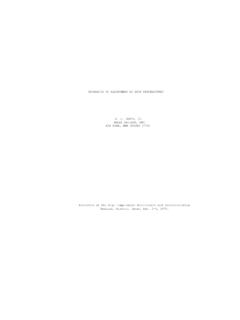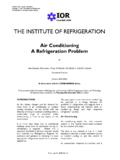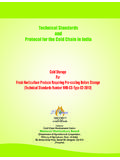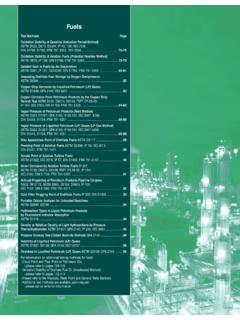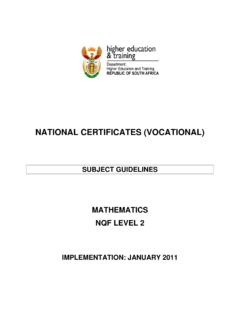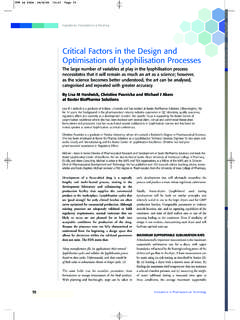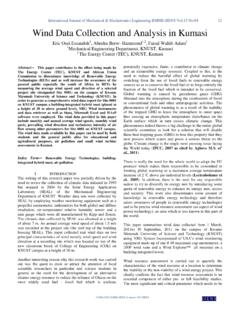Transcription of A comparison of tropical temperature trends with …
1 INTERNATIONAL JOURNAL OF CLIMATOLOGYInt. J. Climatol.(2007)Published online in Wiley InterScience( ) DOI: comparison of tropical temperature trends with modelpredictionsDavid H. douglass ,a* John R. Christy,bBenjamin D. Pearsona ,daDepartment of Physics and Astronomy, University of Rochester, Rochester, NY 14627, USAbDepartment of Atmospheric Science and Earth System Science Center, University of Alabama in Huntsville, Huntsville, AL 35899, USAcScience and Environmental Policy Project, Arlington, VA 22202, USAdUniversity of Virginia, Charlottesville, VA 22903, USAABSTRACT:We examine tropospheric temperature trends of 67runs from 22 Climate of the 20th Century modelsimulations and try to reconcile them with the best availableupdated observations (in the tropics during the satellite era).
2 Model results and observed temperature trends are in disagreement in most of the tropical troposphere, being separated bymore than twice the uncertainty of the model mean. In layers near 5 km, the modelled trend is 100 to 300% higher thanobserved, and, above 8 km, modelled and observed trends have opposite signs. These conclusions contrast strongly withthose of recent publications based on essentially the same data. Copyright 2007 Royal Meteorological SocietyKEY WORDS climate trend; troposphere; observationsReceived 31 May 2007; Accepted 11 October 20071. IntroductionA panel convened by the National Research Coun-cil (2000) found for the satellite era (since 1979) [a]pparently conflicting surface and tropospheric temper-ature trends that could not be reconciled, with the Earth ssurface warming faster than the lower troposphere.
3 Thepanel concluded, after considering possible systematicerrors that [a] substantial disparity remains. From astudy of several independentobservational datasets Dou-glasset al. (2004b) confirmed that the disparity wasreal and arose mostly in the tropical zone. Also, Dou-glasset al. (2004a) showed that three state-of-the-artGeneral Circulation Models(GCMs) predicted a tem-perature trend that increased with altitude, reaching amaximum ratio to the surface trend ( amplification fac-torR) as much as at a pressure (altitude) about200 400 hPa. This was in disagreement with observa-tions, which showed flat or decreasing amplification fac-tors with the Douglasset al. (2004a) study, only three obser-vational datasets were considered, and the number ofmodels was limited to the three most widely present study includes all available datasets, andan Intergovernmental Panel on Climate Change (IPCC)-sponsored model inter- comparison project using the Cli-mate of the 20th Century (20 CEN) forcing includes* Correspondence to: David H.
4 douglass , Department of Physics andAstronomy, University of Rochester, Rochester, NY 14627, : Current address: VWR International, 5100 W. Henrietta Rd.,Rochester, NY 14692, from almost all the major modelling groups [Pro-gram for Climate Model Diagnosis and Intercomparison(PCMDI, 2005)]. The number of observational datasetsand models constitutes a significant increase over theDouglasset al. (2004a) study, and thus, it is appropriatethat a new analysis be al. (2005) recently investigated the altitudedependence of temperature trends during the satellite era,emphasizing the tropical zone, where the characteristicsare well-suited for model evaluation. They comparedavailable observations with 19 of the models and suggestthat any disparity between models and observations isdue to residual errors in the observational datasets.
5 Inthis article, we consider the observational results in 22of the models that were available. As did Santeret al.(2005), we confine our study to the tropical zone butwe reach a different Section 2 we describe the data and the Section 3 we show that the models and the obser-vations disagree to a statistically significant extent. InSection 4 we discuss efforts that have been made toresolve the disparity, and we summarize in Source material and definitionsMuch of the Earth s global mean temperature vari-ability originates in the tropics, which is also theplace where the disparity between model results andobservations is most apparent. For the models andmost of the data, we define tropics operationallyas the region between 20 S and 20 N.
6 In respectCopyright 2007 Royal Meteorological SocietyD. H. DOUGLASSET the Integrated Global Radiosonde Archive (IGRA)and Radiosonde Atmospheric temperature Products forAssessing Climate (RATPAC) datasets (see below), therange is 30 S 30 influence of the major El Ni no of 1997 1998needs clarification. The models, free to produce ElNi nos at differing times and magnitudes, therefore, yieldassociated individual trends not directly comparable withobservations. This results in a mismatch of modelversusobserved El Ni no occurrences. Averaging over a numberof simulations for a model is one way to minimizethe influence of major El Ni no events near the end ofthe record. In Douglasset al. (2004a) the data weretruncated at 1996 to avoid the 1997 1998 event.
7 Nowthe data extend to 2004, and thus, the impact of thissignificant El Ni no is minimized. Hence, the influenceof El Ni nos is effectively removed in both models datasetsWe consider ten sets that measure temperature anomaliesat various altitudes in the troposphere from the surfaceto the SurfaceThree datasets were used: IPCC/HadCRUT2v (Jones andMoberg, 2003), Global Historical Climatology Network(GHCN, 2005), and the NASA Goddard Institute forSpace Studies (GISS, 2005). RadiosondesColeman and Thorne (2005) provide a new analysis(HadAT2) of the Hadley radiosonde dataset. The trendvalues as a function of pressure (altitude) for the tropicalzone (20 S 20 N) are listed in Table I. Freeet al. (2005)have a new dataset based upon the 87-station set ofLanzanteet al.
8 (2003). They provide an updated analysisfor the tropical zone (30 S 30 N) and different analysesof data from the IGRA, and the A and B versions of(RATPAC). We have chosen version B because it isconsistent with IGRA. Haimberger (2006) uses a newtechnique for analysing the European Centre for Medium-Range Weather Forecasts dataset (RAOBCORE), whichadjusts for changes in instrumentation for the 1184radiosonde records. We use version of his data forthe tropics (20 S 20 N). SatellitesThe University of Alabama in Huntsville (UAH, 2007)(Christy and Norris, 2006) and Remote Sensing Systems(RSS) (Mears and Wentz, 2005) provide two indepen-dent analyses of the same Microwave Sounding Unit(MSU) data. These are the only two groups that producereconstructed temperature anomalies for three differenteffective layers in the lower troposphere and lower the lower troposphere and is aweighted mean, with the largest weights from the sur-face to 350 hPa (mean altitude km),T2correspondsto the mid-troposphere with weights extending from thesurface to 70 hPa (mean altitude km) andT4corre-sponds to the lower stratosphere with weights extendingfrom 120 to 20 hPa (mean altitude of 17 km).
9 Here wewill be considering onlyT2 LTandT2. We include, also,theT2results of Vinnikovet al. (2006) (UMD), thoughthis is their only product and is difficult to assess withoutgridded Simple statistical retrievals (SSRs)Johanson and Fu (2006) (JF) demonstrated that a statis-tical combination of MSUT2andT4produces a repre-sentation,TSSR, of the deep troposphere (1000 100 hPa,mean pressure 550 hPa). The form of the equation is(1+a) (T2) a (T4)=TSSR,wherea= In JF,TSSRhas shortcomings due to its reliance on the statisticsof specific sets of radiosondes and specific time peri-ods from which the value of a isdetermined(Christyand Norris, 2006). We do not useTSSRin this study asthe model stratospheric trends needed forTSSRare diffi-cult to accept as realistic.
10 (Christy and Norris providedTable I. Observed tropical temperature trends (milli C/decade). 1979 2004. See note at bottom for explanation of the entriesin the top (pressure) T2 LTT2 999 850700500400300250200150100 DatasetzoneHadCRUT2v20 S 20 N124 GHCN24 S 24 N129 GISS20 S 20 S 20 N5348 RSS20 S 20 N151133 UMD20 S 20 N210 HadAT220 S 20 N61281475 32 147 431 RAOBCORE20 S 20 N131 15 7315849078 71 349 IGRA30 S 30 N176986033929343 66 166 488 RATPAC30 S 30 N12382826811512590 17 117 392 No pressure is assigned to the MSU values (T2 LTandT2) because they result from weighted averages over a range of values (see text). Theentry marked 999 represents the surface, given value 999 for plotting purposes. Other entries in the first row are pressure in 2007 Royal Meteorological SocietyInt.)
